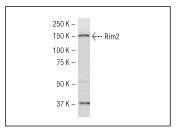Product Detail
Product NameRIM 2 Antibody
Clone No.3G2
Host SpeciesMouse
ClonalityMonoclonal
PurificationProA affinity purified
ApplicationsWB, IP
Species ReactivityHu, Rt
Immunogen Descpeptide
ConjugateUnconjugated
Other NamesKIAA0751 antibody Non small cell lung cancer RimL3a protein antibody Non small cell lung cancer RimL3c protein antibody OBOE antibody Protein regulating synaptic membrane exocytosis 2 antibody Rab-3-interacting molecule 2 antibody Rab-3-interacting protein 3 antibody Rab3 interacting molecule 2 antibody RAB3IP3 antibody Regulating synaptic membrane exocytosis 2 antibody Regulating synaptic membrane exocytosis protein 2 antibody RIM 2 antibody Rims2 (gene name) antibody Rims2 antibody RIMS2_HUMAN antibody
Accession NoSwiss-Prot#:Q9UQ26
Uniprot
Q9UQ26
Gene ID
9699;
Calculated MW160kDa
Formulation1*TBS (pH7.4), 1%BSA, 40%Glycerol. Preservative: 0.05% Sodium Azide.
StorageStore at -20˚C
Application Details
WB: 1:100-1:1,000
IHC: 1:50-500
IP: 1-2 μg per 100-500 μg of total protein(1 ml of cell lysate)
Western blot analysis of Rim2 expression in PC-12 whole cell lysate.
Rab3, a neural/neuroendocrine-specific member of the Rab family, is involved in Ca2+-regulated exocytosis. Rab3 functions in an inhibitory capacity by controlling the recruitment of secretory vesicles into a releasable pool at the plasma membrane. Rim (rab3 interacting molecule), a putative effector protein for Rab3s, is composed of an N-terminal zinc-finger motif and C-terminal PDZ and C2 domains. Rim exists as two variants, Rim1 and Rim2, produced by alternative splicing. The 3-end of the Rim2 gene produces an independent mRNA that encodes a smaller protein referred to as Nim2, which like Rim, also regulates exocytosis. Rim serves as a Rab3-dependent regulator of synaptic-vesicle fusion by forming a GTP-dependent complex between synaptic plasma membranes and docked synaptic vesicles. Both Rim1 and Rim2 can bind to cAMP-GEFII, which is a direct target of cAMP in regulated exocytosis and is responsible for cAMP-dependent, PKA-dependent exocytosis. Rim also localizes on the plasma membrane of INS-1E cells and pancreatic beta-cells. Rab3 binding domain of Rim enhances glucose-stimulated secretion in intact cells and Ca2+-stimulated exocytosis in permeabilized cells, suggesting that Rim may also play a regulatory role in insulin secretion.
If you have published an article using product 48334, please notify us so that we can cite your literature.



 Yes
Yes



